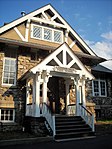Hurst-Pierrepont Estate
Gothic Revival architecture in New York (state)Houses completed in 1867Houses in Putnam County, New YorkHouses on the National Register of Historic Places in New York (state)Hudson Valley, New York Registered Historic Place stubs ... and 1 more
National Register of Historic Places in Putnam County, New York

Hurst-Pierrepont Estate is a historic estate located at Garrison in Putnam County, New York. It was designed by architect Alexander Jackson Davis (1803-1892) for Edwards Pierrepont (1817-1892) and built in 1867. It is a two-story brick Gothic villa. It features a four-story, flat roofed tower. Also on the property is a cow barn and carriage house.It was listed on the National Register of Historic Places in 1982.
Excerpt from the Wikipedia article Hurst-Pierrepont Estate (License: CC BY-SA 3.0, Authors, Images).Hurst-Pierrepont Estate
Beckwith Lane,
Geographical coordinates (GPS) Address Nearby Places Show on map
Geographical coordinates (GPS)
| Latitude | Longitude |
|---|---|
| N 41.379166666667 ° | E -73.938611111111 ° |
Address
Beckwith Lane 24
10524
New York, United States
Open on Google Maps









